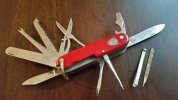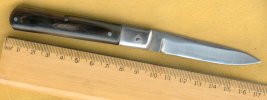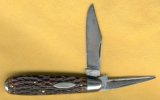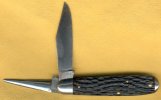-
The BladeForums.com 2024 Traditional Knife is available! Price is $250 ea (shipped within CONUS).
Order here: https://www.bladeforums.com/help/2024-traditional/
You are using an out of date browser. It may not display this or other websites correctly.
You should upgrade or use an alternative browser.
You should upgrade or use an alternative browser.
"Old Knives"
- Thread starter VCM3
- Start date
Campbellclanman
Platinum Member
- Joined
- Mar 10, 2007
- Messages
- 15,820
A Sheffield beauty there J
This Robeson EZ open Jack arrived today. I posted it's twin a few pages back. The first one I posted had more of a green bone mark cover and redbone pile cover. This new arrival (pictured on top) has more uniformed covers. The pen blade on the new one is a little less full though.
Both blades are solid and the covers are perfect.




I just had to bring forward these beauties.
Last edited:
waynorth
Dealer / Materials Provider
- Joined
- Nov 19, 2005
- Messages
- 33,346
- Joined
- Dec 19, 2006
- Messages
- 8,210
Nice Robeson ! It's a harness jack for miniature horses ! 
Campbellclanman
Platinum Member
- Joined
- Mar 10, 2007
- Messages
- 15,820
Charlie - that's a Sweetheart of a HJ.
Absolutely incredible condition!
Absolutely incredible condition!
Last edited:
- Joined
- Dec 2, 2005
- Messages
- 71,133
Picked up this Wilkinson seven blade folder for a little inspiration. Outside of the corrosion and a broken main blade and scissors spring, it seems unused. Still has some gold wash in the filework. And the pearl handles still sparkle. Main blade has a three line stamp...... "F" and a letter I can't make out on the first line; "Wilkinson" on second line; "Sheffield" on third line.
Haven't been able to find much info on Wilkinson knives.
J
JDWARE KNIVES


Nice find my friend
 Tweedale lists a number of Wilkinson cutlers - 3 Henrys, Henry Dawson, Thomas, Walter, William, and Wilkinson Sword - though Wilkinson could also be the name of a factor of course. Lots of Sheffield cutlers made that style of Lobster, and made them well
Tweedale lists a number of Wilkinson cutlers - 3 Henrys, Henry Dawson, Thomas, Walter, William, and Wilkinson Sword - though Wilkinson could also be the name of a factor of course. Lots of Sheffield cutlers made that style of Lobster, and made them well 
Last edited:
- Joined
- Jun 9, 2010
- Messages
- 4,333
Haven't posted this knife for a few of years, and what with Paul showing us those beautiful Robeson EOs, I thought I'd help celebrate that great Robeson jigging. This is one I call a "junior" HJ - a little smaller than a full 3 1/2 to 3 3/4" HJ.
View attachment 731944 View attachment 731945
Awesome jigging, unique punch, and I don't remember seeing a jack with one tip bolster!

- Joined
- Mar 26, 2004
- Messages
- 24,735
Awesome jigging, unique punch, and I don't remember seeing a jack with one tip bolster!
I never even noticed the bolsters. That is unique. I was too busy looking at the jigging.
Haven't posted this knife for a few of years, and what with Paul showing us those beautiful Robeson EOs, I thought I'd help celebrate that great Robeson jigging. This is one I call a "junior" HJ - a little smaller than a full 3 1/2 to 3 3/4" HJ.
View attachment 731944 View attachment 731945
Absolute gorgeous knife!!! That size must be very uncommon among other cutlery companies???
Campbellclanman
Platinum Member
- Joined
- Mar 10, 2007
- Messages
- 15,820
I more than Like that Knife Charlie..
Here is a couple of examples of the smaller Bolsters mentioned above
Charlie my friend - not quite as tidy as your Pristine example - but still a great little HJ! and one that shares the same incredible Jig Work....


Another beautiful HJ- same size again and again with outstanding Jig Work on this Knife,This example ( made by Utica ) was so kindly gifted to me by Paul Hilborn- again Paul MANY Thanks for this wee sweetheart!

Here is a couple of examples of the smaller Bolsters mentioned above
Charlie my friend - not quite as tidy as your Pristine example - but still a great little HJ! and one that shares the same incredible Jig Work....


Another beautiful HJ- same size again and again with outstanding Jig Work on this Knife,This example ( made by Utica ) was so kindly gifted to me by Paul Hilborn- again Paul MANY Thanks for this wee sweetheart!

Last edited:
- Joined
- Jun 28, 2016
- Messages
- 447
Since the majority of my collecting has been of vintage SAKs up until recently, I thought I'd share kind of a rarer piece not often seen. A 6 layer Wengerinox model from the 1940s. It's got a wood saw, can opener and cap lifter layer, scissors with original single leaf spring, fish scaler and hook remover a snow and mud boot scraper and the spear and clip point blade layer. Original toothpick and nickel silver tweezers and bail. I really like the old shield inlays. This knife is in phenomenal shape.

Last edited:
- Joined
- Jun 28, 2016
- Messages
- 447
Great "jr." HJs, Duncan! Nice examples of the breed!!
Neat old Wenger, NS!! 3-D shields need a thread, IMO!!
Charlie, if you have any examples of interesting SAK shields/inlays and want to start a thread I will definitely contribute, I've got a number of nice ones. USMC seal, National Ski Patrol, Old crossbow shields and cross shields of different varieties.
- Joined
- Jun 28, 2016
- Messages
- 447
I don't have SAKs, but I have other brands. I'll start one in the next day or so - - - unless someone wants to go for it sooner!!??
Your threads always have cachet lol, I'm positive it would get more traffic if you started it.
Some nice knives posted above 
 ... especially like those HJs Charlie and Duncan
... especially like those HJs Charlie and Duncan 
Here are a few different old knives for this thread and I say with a grin not associated with cutting apples but I guess someone could if they wanted .. Two old dirks or maybe more appropriately daggers with different origins but both with that classic swedge associated with these single edge cutting blades running along the spine from tang to tip (though the Frosolone knife is technically called a sfilato from its Italian roots)…. Just as an aside I think the terminology is somewhat cloudy and confusing for dirk vs dagger and it no doubt depends on who you read - I believe technically these are dirks (despite some who define daggers as double cutting edge knives) - small daggers in Scotland are called dirks and are single cutting edges – yet large pointed symmetrical blade that are almost short swords are also called dirks or daggers again depending who you read.... guess I’ll go with dirk for the first knife which can be defined as a small dagger
.. Two old dirks or maybe more appropriately daggers with different origins but both with that classic swedge associated with these single edge cutting blades running along the spine from tang to tip (though the Frosolone knife is technically called a sfilato from its Italian roots)…. Just as an aside I think the terminology is somewhat cloudy and confusing for dirk vs dagger and it no doubt depends on who you read - I believe technically these are dirks (despite some who define daggers as double cutting edge knives) - small daggers in Scotland are called dirks and are single cutting edges – yet large pointed symmetrical blade that are almost short swords are also called dirks or daggers again depending who you read.... guess I’ll go with dirk for the first knife which can be defined as a small dagger  ….
….
This first dirk found on a local antique barn hunt appears that it was most likely made in Sheffield or one of the other areas for cutlery in the UK though I can’t rule out early American either (showing to a few other collectors I heard Sheffield as most likely and recently I saw an old Sheffield made jack that was a barehead and squared off as seen in this knife so essentially the same design – so at least the style was possible from Sheffield) – absolutely no signs of a tang stamp or makers mark so tough to identify in terms of a maker… anyway all iron construction including liners, bolster and lockback… still a very functional knife with snap and solid, and the lock-back works perfectly. This knife no doubt was well carried for years – the stag is very pocket worn and no doubt thin from years of carry which to me is pretty cool – it does look like there was 2 pins added to the mark side handle and done very cleanly which probably reinforced the stag to the liner but have no clue when along the way this was done as a means to preserve the handle cover (from a personal standpoint it is not something I would do but this knife may have lost the mark side stag if not for the extra pins so in a way I’m good with it – no doubt rest of pins are all original… my guess on age of knife is +/- mid 1800s… no doubt this was the type of knife carried as a weapon but probably could have seen some other cutting purposes as well… Closed length is 4 & 1/2”…
– no doubt rest of pins are all original… my guess on age of knife is +/- mid 1800s… no doubt this was the type of knife carried as a weapon but probably could have seen some other cutting purposes as well… Closed length is 4 & 1/2”…



The second is not one I ordinarily collect as it is outside my geographic collecting zone but I couldn’t resist it a few years ago when discovered on another local hunt at an “antique” barn – I categorize these knives as my “special opportunities” part of my accumulation
but I couldn’t resist it a few years ago when discovered on another local hunt at an “antique” barn – I categorize these knives as my “special opportunities” part of my accumulation  … The knife is stamped and made in Frosolone (Italy) and Frosolone was no doubt an important center of knife making in the world in the latter 1800s - early 1900s and still today has some active cutleries though not as numerous as the past.. I believe in 1900 there were more than eighty cutlery shops in addition to a big steel industry… Like the first one this also has all iron construction and despite the crack and few marks on horn handles it is a very solid knife (that crack in the horn on mark side is solid and not going anywhere and most likely occurred with age and drying)… These knives were termed sfilatos in Italy and many cutlers made this design. Interesting that the stamp of “Frosolone” is upside down in terms of what is normally seen on tang stamps in addition to no maker mark… as I read about Frosolone in the late 1800s it was in a sense very much like Sheffield with many makers and shops, lots of apprentices etc, and thus very hard if not impossible now to nail down the maker… knives from Frosolone were known for blade stamps or etches rather than found conventionally on the tang but I suppose both were done pending the cutler – additionally not all cutlers used their name as some only stamped Frosolone… Frosolone still has some knife makers today and I sent photos of this knife to a current Frosolone cutler who appears to be well versed in Frosolone history – he confirmed the knife was made in the latter quarter of the1800s and no later than very early 1900s… he noted it was a classic design in all ways for that time period based on materials etc. Some other background reading noted that when lockback knives became illegal in Italy in 1871 this folding sfilato was developed and continued as a style still associated with Frosolone today… Closed length is 4 & 7/8” …
… The knife is stamped and made in Frosolone (Italy) and Frosolone was no doubt an important center of knife making in the world in the latter 1800s - early 1900s and still today has some active cutleries though not as numerous as the past.. I believe in 1900 there were more than eighty cutlery shops in addition to a big steel industry… Like the first one this also has all iron construction and despite the crack and few marks on horn handles it is a very solid knife (that crack in the horn on mark side is solid and not going anywhere and most likely occurred with age and drying)… These knives were termed sfilatos in Italy and many cutlers made this design. Interesting that the stamp of “Frosolone” is upside down in terms of what is normally seen on tang stamps in addition to no maker mark… as I read about Frosolone in the late 1800s it was in a sense very much like Sheffield with many makers and shops, lots of apprentices etc, and thus very hard if not impossible now to nail down the maker… knives from Frosolone were known for blade stamps or etches rather than found conventionally on the tang but I suppose both were done pending the cutler – additionally not all cutlers used their name as some only stamped Frosolone… Frosolone still has some knife makers today and I sent photos of this knife to a current Frosolone cutler who appears to be well versed in Frosolone history – he confirmed the knife was made in the latter quarter of the1800s and no later than very early 1900s… he noted it was a classic design in all ways for that time period based on materials etc. Some other background reading noted that when lockback knives became illegal in Italy in 1871 this folding sfilato was developed and continued as a style still associated with Frosolone today… Closed length is 4 & 7/8” …




Cheers!
Lee

 ... especially like those HJs Charlie and Duncan
... especially like those HJs Charlie and Duncan 
Here are a few different old knives for this thread and I say with a grin not associated with cutting apples but I guess someone could if they wanted
This first dirk found on a local antique barn hunt appears that it was most likely made in Sheffield or one of the other areas for cutlery in the UK though I can’t rule out early American either (showing to a few other collectors I heard Sheffield as most likely and recently I saw an old Sheffield made jack that was a barehead and squared off as seen in this knife so essentially the same design – so at least the style was possible from Sheffield) – absolutely no signs of a tang stamp or makers mark so tough to identify in terms of a maker… anyway all iron construction including liners, bolster and lockback… still a very functional knife with snap and solid, and the lock-back works perfectly. This knife no doubt was well carried for years – the stag is very pocket worn and no doubt thin from years of carry which to me is pretty cool – it does look like there was 2 pins added to the mark side handle and done very cleanly which probably reinforced the stag to the liner but have no clue when along the way this was done as a means to preserve the handle cover (from a personal standpoint it is not something I would do but this knife may have lost the mark side stag if not for the extra pins so in a way I’m good with it



The second is not one I ordinarily collect as it is outside my geographic collecting zone




Cheers!
Lee
waynorth
Dealer / Materials Provider
- Joined
- Nov 19, 2005
- Messages
- 33,346
Nice old knives, Lee!
Uno Sfilato Bello!!
This Sfilato was made by one of the Mirandos. Felix and Michael Mirando came to America to work in the burgeoning cutlery industry at Empire. They left Empire to eventually form Imperial, and at some point their father came over from Frosolone to help them out.
This knife was found in the Schrade collection around 2004, when Schrade closed.




Uno Sfilato Bello!!
This Sfilato was made by one of the Mirandos. Felix and Michael Mirando came to America to work in the burgeoning cutlery industry at Empire. They left Empire to eventually form Imperial, and at some point their father came over from Frosolone to help them out.
This knife was found in the Schrade collection around 2004, when Schrade closed.






